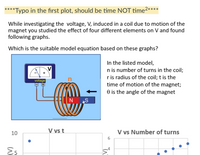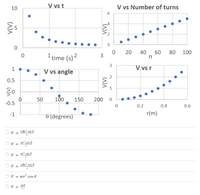
College Physics
11th Edition
ISBN: 9781305952300
Author: Raymond A. Serway, Chris Vuille
Publisher: Cengage Learning
expand_more
expand_more
format_list_bulleted
Concept explainers
Question

Transcribed Image Text:*Typo in the first plot, should be time NOT time2
*****
2****
While investigating the voltage, V, induced in a coil due to motion of the
magnet you studied the effect of four different elements on V and found
following graphs.
Which is the suitable model equation based on these graphs?
In the listed model,
n is number of turns in the coil;
r is radius of the coil; t is the
time of motion of the magnet;
O is the angle of the magnet
voltage
N S
10
V vs t
V vs Number of turns
6
LO

Transcribed Image Text:V vs t
V vs Number of turns
10
6
.5
20
40
60
80
100
1
3
time (s)2
3
1
V vs r
V vs angle
0.5
1
50
100
150
200
-0.5
0.2
0.4
0.6
-1
r(m)
0 (degrees)
n Br² sin 0
V =
t
nr2 cos 0
V =
t
nr2 sin 0
V =
t
n Br2 cos 0
V =
V = ntr² cos 0
nr0
V
Expert Solution
This question has been solved!
Explore an expertly crafted, step-by-step solution for a thorough understanding of key concepts.
Step by stepSolved in 2 steps with 2 images

Knowledge Booster
Learn more about
Need a deep-dive on the concept behind this application? Look no further. Learn more about this topic, physics and related others by exploring similar questions and additional content below.Similar questions
- Two parallel metal plates separated by 20 cm are connected across a 12 V potential difference. An electron is released from rest at a location 10 cm from the negative plate. When the electron arrives at a distance 5 cm from the positive plate, how much kinetic energy has the electron gained? Hint: First you will need to calculate the value of the electric field between the plates, then the potential difference between the initial and final positions. Now use the Work–Energy Theorem. Standard units!arrow_forwardHow would you rearrange that equation for m_0arrow_forwardA negatively charged particle of mass 4.30 x 10-19 kg is moving with a speed of 35.0 m/s when it enters the region between two parallel capacitor plates. The initial velocity of the charge is parallel to the plate surfaces and in the positive x-direction. The plates are square with a side of 1.00 cm, and the voltage across the plates is 2.50 V. If the particle is initially 1.00 mm from both plates and it just barely clears the positive plate after traveling 1.00 cm through the region between the plates, how many excess electrons are on the particle? Ignore gravitational and edge effects. 35.0 m/s 2.00 mm 1.00 cm Numeric Responsearrow_forward
- What is the magnitude, in volts, of the maximum potential difference between two parallel conducting plates separated by 0.51 cm of air?arrow_forwardThe electric field between two concentric cylindrical conductor at r = 0.01m and r = 0.05 m is given by E 105 f. The energy stored in a 0.5 length (assuming free space) 2.224 J O 1.224 J O 3.224 J O 0.224 Jarrow_forwardA 3.0 cm × 3.0 cm parallel-plate capacitor has a 1.0 mm spacing. The electric field strength inside the capacitor is 1.5×105 V/m .How much charge is on each plate?arrow_forward
- A carbon nucleus and an iron nucleus are initially located 7.37 nm apart from one another. How much work would it take to move the carbon nucleus to a new distance of 1.75 nm from the iron nucleus? 68.5 eV 97.8 eV 117.4 eV 156.5 eVarrow_forwardHow do I rearrange this equation so that I am solving for t?arrow_forwardYou have an atomic nucleus with 6 protons at x = 5.2 Angstroms on the x-axis. How much work would it take to bring in ANOTHER nucleus with 5 protons from 1 m away and place it at y = 2.3 Angstroms on the y-axis? 17.8 eV 44.6 eV -31.3 eV 75.9 eVarrow_forward
- Sarrow_forwardQuestion 7 b(ii) , b(iii) and 7 a(ii) , 7a(i)arrow_forwardTwo plates are lying horizontally, but stacked with one 10.0 cm above the other. If the upper plate is held at +100 V, what is the magnitude and direction of the electric field between the plates if the lower is held at +50.0 V? -50.0 V? a. 500 V/m, 1500 V/m, down b. 500 V/m, 1500 V/m, up c. 1500 V/m, 500 V/m, down d. 1500 V/m, 500 V/m, uparrow_forward
arrow_back_ios
SEE MORE QUESTIONS
arrow_forward_ios
Recommended textbooks for you
 College PhysicsPhysicsISBN:9781305952300Author:Raymond A. Serway, Chris VuillePublisher:Cengage Learning
College PhysicsPhysicsISBN:9781305952300Author:Raymond A. Serway, Chris VuillePublisher:Cengage Learning University Physics (14th Edition)PhysicsISBN:9780133969290Author:Hugh D. Young, Roger A. FreedmanPublisher:PEARSON
University Physics (14th Edition)PhysicsISBN:9780133969290Author:Hugh D. Young, Roger A. FreedmanPublisher:PEARSON Introduction To Quantum MechanicsPhysicsISBN:9781107189638Author:Griffiths, David J., Schroeter, Darrell F.Publisher:Cambridge University Press
Introduction To Quantum MechanicsPhysicsISBN:9781107189638Author:Griffiths, David J., Schroeter, Darrell F.Publisher:Cambridge University Press Physics for Scientists and EngineersPhysicsISBN:9781337553278Author:Raymond A. Serway, John W. JewettPublisher:Cengage Learning
Physics for Scientists and EngineersPhysicsISBN:9781337553278Author:Raymond A. Serway, John W. JewettPublisher:Cengage Learning Lecture- Tutorials for Introductory AstronomyPhysicsISBN:9780321820464Author:Edward E. Prather, Tim P. Slater, Jeff P. Adams, Gina BrissendenPublisher:Addison-Wesley
Lecture- Tutorials for Introductory AstronomyPhysicsISBN:9780321820464Author:Edward E. Prather, Tim P. Slater, Jeff P. Adams, Gina BrissendenPublisher:Addison-Wesley College Physics: A Strategic Approach (4th Editio...PhysicsISBN:9780134609034Author:Randall D. Knight (Professor Emeritus), Brian Jones, Stuart FieldPublisher:PEARSON
College Physics: A Strategic Approach (4th Editio...PhysicsISBN:9780134609034Author:Randall D. Knight (Professor Emeritus), Brian Jones, Stuart FieldPublisher:PEARSON

College Physics
Physics
ISBN:9781305952300
Author:Raymond A. Serway, Chris Vuille
Publisher:Cengage Learning

University Physics (14th Edition)
Physics
ISBN:9780133969290
Author:Hugh D. Young, Roger A. Freedman
Publisher:PEARSON

Introduction To Quantum Mechanics
Physics
ISBN:9781107189638
Author:Griffiths, David J., Schroeter, Darrell F.
Publisher:Cambridge University Press

Physics for Scientists and Engineers
Physics
ISBN:9781337553278
Author:Raymond A. Serway, John W. Jewett
Publisher:Cengage Learning

Lecture- Tutorials for Introductory Astronomy
Physics
ISBN:9780321820464
Author:Edward E. Prather, Tim P. Slater, Jeff P. Adams, Gina Brissenden
Publisher:Addison-Wesley

College Physics: A Strategic Approach (4th Editio...
Physics
ISBN:9780134609034
Author:Randall D. Knight (Professor Emeritus), Brian Jones, Stuart Field
Publisher:PEARSON